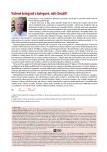Periurethral agents in the treatment of urinary incontinence on the basis of the urethral sphincter insufficiency
Authors:
Zdeněk Adamík 1,2
Authors‘ workplace:
Gynekologicko-porodnické oddělení KNTB, a. s., Zlín, primář MUDr. Zdeněk Adamík, Ph. D.
1; Institut zdravotnických studií, Univerzita Tomáše Bati, Zlín
2
Published in:
Prakt Gyn 2013; 17(2): 146-148
Category:
Urogynecology: Review Article
Overview
Urethral sphincter insufficiency (ISD) is the incontinence of urine specific problem, because it means a reduction intraurethral pressure at the lack of the activity of the sphincter muscle. From the physical point of view there are three components: 1. the rules of statics of fluids (the ratio of the intraabdominal pressure and atmospheric pressure), 2. the rules flowing liquids (on the basis of Bernoulli's equation), 3. biophysical properties of the sphincter. Sphincter insufficiency causes mechanical leak under pressure drop. This type of incontinence is very difficult to treat. Basically we are using two methods. The implantation of retropubic tape with the possibility of a stroke when you stress test maneuvers or periurethral agents. Both of these methods increase the intraurethral pressure. The syndrome known as "frozen urethra", where the urethra does not move, it is preferable to use periurethral agents. We studied the effectiveness of Bulkamid methods for the treatment of ISD.
Key words:
periurethral agents – sphincter insuffi ciency – urinary incontinence
Sources
1. Abrams P, Blavias JG, Stanton SL. The standardisation of terminology of lower urinary tract function. Scand J Urol Nephrol 1988; 114(6): 5–19.
2. Halaška M, Voigt R. Teoretické základy problematiky inkontinence moči. In: Halaška M et al. Urogynekologie. Galén: Praha 2004 : 5–6.
3. Valerio M, Jichlinski P, Dahlem R et al. Experimental evaluation of an electromechanical artificial urinary sphincter in an animal mode. BJU Int 2013. Dostupné z DOI: <http://doi: 10.1111/j.1464–410X.2012.11728.x>.
4. Lose G, Sørensen HC, Axelsen SM et al. An open multicenter study of polyacrylamide hydrogel (Bulkamid®) for female stress and mixed urinary incontinence. Int Urogynecol J 2010; 21(12): 1471–1477.
5. Maggiore ULR, Alessandri F, Medica M et al. Outpatient periurethral injections of polyacrylamide hydrogel for the treatment of female stress urinary incontinence: effectiveness and safety. Arch Gynecol Obstet 2013. Dostupné z DOI: <http://doi: 10.1007/s00404–013–2718-y>
6. Klarskov N, Lose G. Urethral injection therapy: what is the mechanism of action? Neurourol Urodyn 2008; 27(8): 789–792. Dostupné z DOI: <http://doi: 10.1002/nau.20602>.
7. Kelleher CJ, Cardozo LD, Khullar V, Salvatore S. A new questionnaire to assess the quality of life of urinary incontinent women. Br J Obstet Gynaecol 1997; 104(12): 1374–1379.
8. Jeong MY, Kim SJ, Kim HS et al. Comparison of Efficacy and Satisfaction between the TVT-SECUR® and MONARC® Procedures for the Treatment of Female Stress Urinary Incontinence Korean J Urol 2010; 51(11):767–771. Dostupné z DOI: <http://doi: 10.4111/kju.2010.51.11.767>.
9. Mohr S, Siegenthaler M, Mueller MD et al. Bulking agents: an analysis of 500 cases and review of the literature Int Urogynecol J. 2013; 24(2): 241–247. Dostupné z DOI: <http://doi: 10.1007/s00192–012–1834–8>.
Labels
Paediatric gynaecology Gynaecology and obstetrics Reproduction medicineArticle was published in
Practical Gynecology

2013 Issue 2
Most read in this issue
- Repeated sectio caesarea, over and over: case report
- Guidelines for the thyroid diseases diagnosis and management in pregnancy and women with fertility disorders
- Complications after ovarian stimulation in vitro fertilization require admission to surgery
- Myoinositol – new possibility in treatment of polycystic ovary syndrome
